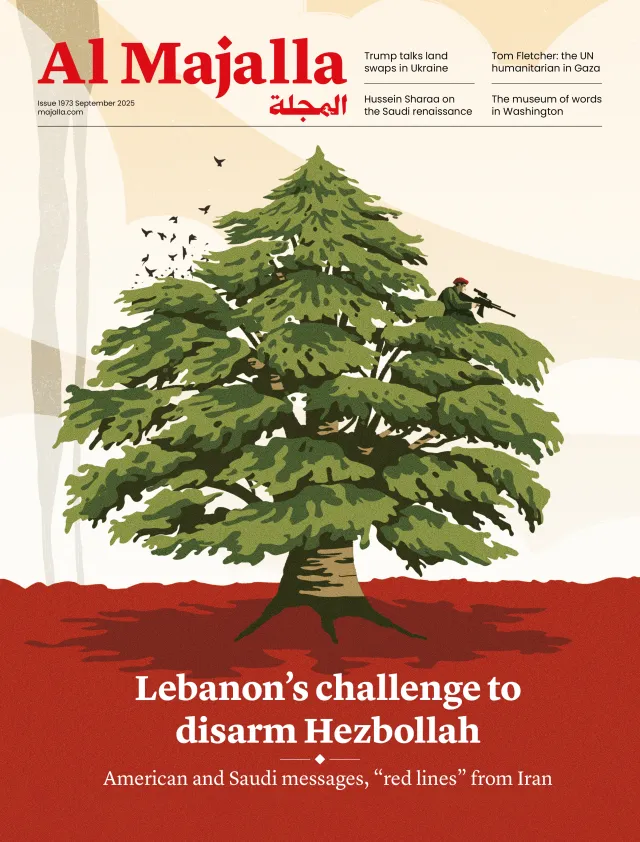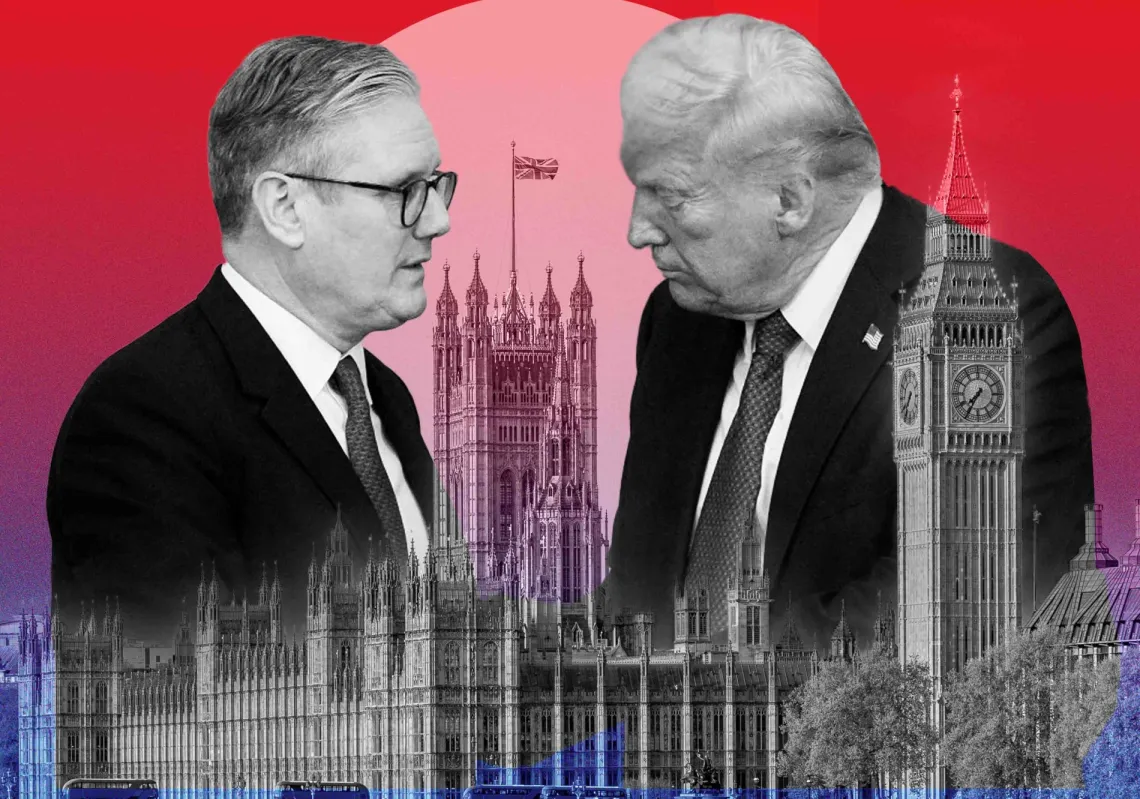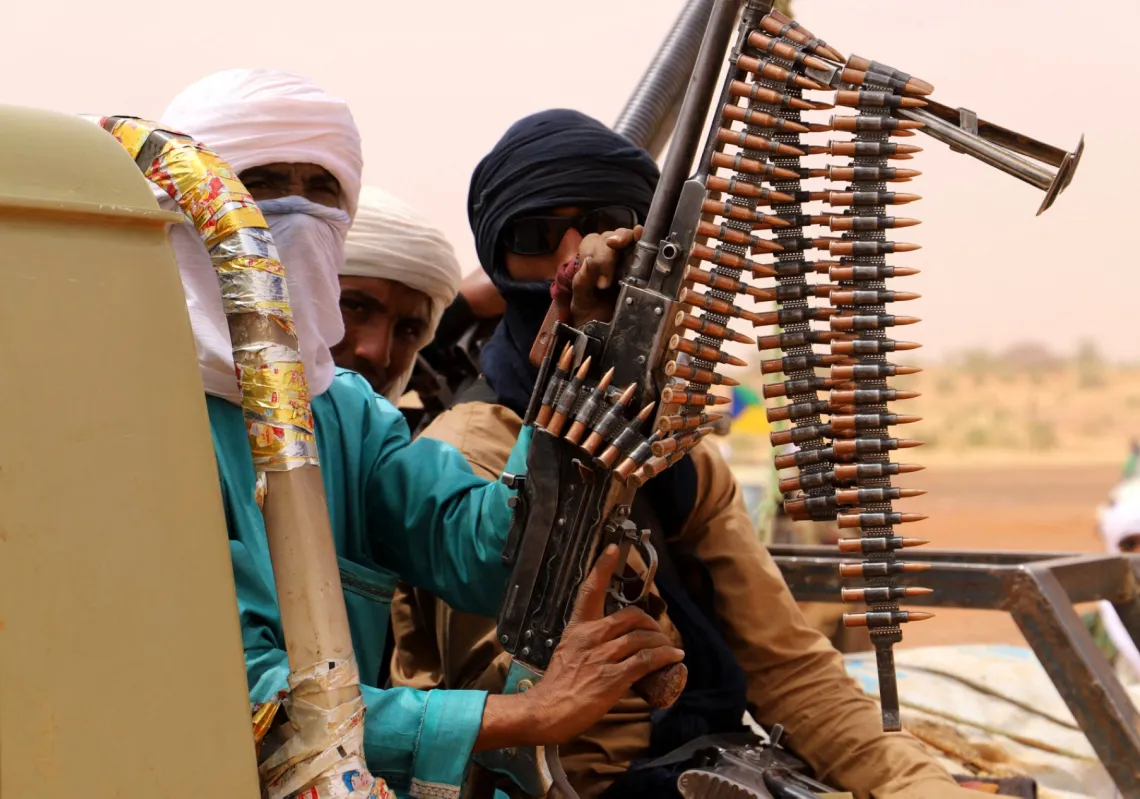 ARLINGTON, VA - MAY 26: Martin Dempsey, Chairman of the Joint Chiefs of Staff, speaks during a Memorial Day event at Arlington National Cemetery, May 26, 2014 in Arlington, Virginia. Obama returned to Washington the morning of May 26, after a surprise visit to Afghanistan to visit U.S. troops at Bagram Air Field. (Pool photo by Drew Angerer/Getty Images)[/caption]
ARLINGTON, VA - MAY 26: Martin Dempsey, Chairman of the Joint Chiefs of Staff, speaks during a Memorial Day event at Arlington National Cemetery, May 26, 2014 in Arlington, Virginia. Obama returned to Washington the morning of May 26, after a surprise visit to Afghanistan to visit U.S. troops at Bagram Air Field. (Pool photo by Drew Angerer/Getty Images)[/caption]
Foreign Affairs
In September 2015, General Martin Dempsey retired from the U.S. Army after more than four decades in uniform. Commissioned as an armor officer following his graduation from West Point, he served in both the Gulf War and the Iraq war and eventually rose to become chief of staff of the U.S. Army and then chairman of the Joint Chiefs of Staff. He spoke with Foreign Affairs’ editor, Gideon Rose, in June.
You have said that you think this is the most dangerous the world has ever been. Why are you so concerned?
It’s the most dangerous period in my lifetime. In my 41 years of military experience, we often had the opportunity to focus on one security threat or another. First it was all about the Soviet Union, then it was peacekeeping, then it was terrorism. Now we’ve got lots of things cropping up at the same time. We have multiple challenges competing for finite resources—and grotesque uncertainty with regard to the military budget.
But are any of today’s challenges at the scale of previous ones? It sounds like you’re worried about a broad range of minor threats rather than one or two really big ones.
We could debate how minor the threats are. I would suggest that left unattended, they could become much bigger threats than we appreciate today. State actors like Russia and China are challenging our interests in Europe and in the Pacific. Neither is a peer competitor yet, but there are parts of their enterprises where they’re approaching the status of peer competitors. And then you have nonstate actors like ISIS. We are not in a position where we can ignore any of these issues. And underpinning it all is our inability to take a longer view—say, 20 years—and support it with the policies, authorities, and resources necessary. Instead, we tend to look at things one year at a time.
Do you worry that what Russia has done on its periphery will escalate to a direct challenge to NATO countries that have an Article 5 security guarantee?
Russia is clearly trying to reestablish a sphere of influence in the gray states that sit between the Russian Federation and NATO. They are looking to reestablish a group of nations who can be their satellites, who can help them bolster their economy and their security, because as they look into the period beyond 2020, most of their trend lines are declining. China’s not looking to make allies; it’s looking to make economic trading partners to make sure it has the resources it needs to fuel its economy and manage its 1.5-billion-plus population. In contrast to both Russia and China, our future security is based on our alliance structure, which goes back to World War II and its aftermath. So here is where it becomes something to be wary of: Russia’s buffer zone is going to rub uncomfortably at points against our alliance structure in Europe. China’s efforts to establish supply chains and garner resources are going to rub uncomfortably at points against our alliance structure in the Pacific. That causes me concern.
But isn’t the alliance structure you just described a source of strength rather than weakness? If you add up the United States and its allies and partners, you end up with something like two-thirds or three-quarters of global defense spending. Why should the people who have all that be so worried about challenges from much weaker countries with much fewer resources and alliances?
Our allies and partners tend to be a bit fragmented in terms of their interests. If you were talking to one of my NATO counterparts, they might define the Russian threat as most serious, but another might consider immigration or terrorism the greater threat. Russia can affect the NATO alliance in two ways. One is by threatening it physically on its eastern flank, and the other is by threatening to sever the transatlantic link. There are capabilities that the Russians are pursuing that are clearly intended to allow them to threaten our ability to reinforce Europe, and if they could do that, then NATO would lose credibility pretty quickly.
What specific capabilities do you have in mind?
Some are still classified. But let’s just say, for example, capabilities they’re developing in space, in cyber, with ground-based cruise missiles, underwater capabilities, are all intended to eventually be able to threaten the transatlantic link and put NATO in a precarious position.
The flash points between China and its neighbors have come recently in the South and East China Seas. Has the U.S. response been too much, too little, or just right?
I think our actions to date have been intended to send a clear signal that we’ve got several allies in the Pacific with whom we share interests and commitments, and if Chinese assertions of sovereignty threaten them, then we have a treaty obligation to support them. Have we done enough in that region? I think we’ve got it about right. On occasion, I argued for more frequent freedom-of-navigation operations—FONOPSs—to make it clear that China can go out and do a land reclamation project, but it’s not going to have any effect [on the legal status quo]. We’re not going to honor a 12-mile territorial boundary [around their newly reclaimed land]. We’ve got to keep that up, because if someone declares something and no one challenges it, it can become accepted. I would have preferred more frequent freedom-of-navigation operations. But I think the way we’ve done it has been prudent.
Some have argued that what we’ve actually done has been more innocent passage than traditional FONOPs.
That distinction is more a matter of law—of the declaration you make, the way you maneuver inside that space. I don’t think that matters much to the Chinese. I think they recognize that our presence there is a signal. My Chinese counterparts were pretty clear about the fact that they didn’t appreciate us asserting the right to do that kind of operation, whatever we call it.
There have been a number of incidents in which U.S. ships or planes have been buzzed by foreign military aircraft. Is the proper response to those kinds of situations to ignore them or to escalate?
You have to make note of them and protest them, both in diplomatic and in military channels. One of the things that fascinated me about the Chinese is whenever I would have a conversation with them about international standards or international rules of behavior, they would inevitably point out that those rules were made when they were absent from the world stage. They are no longer absent from the world stage, and so those rules need to be renegotiated with them. We continued to make the assertion that in the interests of safety, if nothing else, we really needed to have these rules of behavior. And we were successful initially in maritime rules of behavior. We took much longer on standards of behavior in the air, and I’m not sure we ever closed the deal on my watch.
Regarding nonstate actors, there are the ones on the ground in foreign conflict zones, such as ISIS, but then there are also global terrorist networks with affiliates, offshoots, and radicalized local supporters in many countries. What, if anything, can the U.S. military do about domestic terrorist attacks carried out by U.S. citizens?
There are indeed two kinds of challenges from radical Islamist groups. Some actually stand and seek to hold ground. Such groups need to be countered on the ground, with most of the fight coming from those who have the most to gain and lose—and that means we have to work with and through people from the region who are willing to fight. This might take far longer than it would if we were to do the job ourselves, but it is necessary because we have to adopt a response that can be sustained for a long time, such as 20 years. As for individuals who are being radicalized online, groups like ISIS are losing the fight on the ground and probably winning the fight in the virtual environment because it’s so hard to fight them there. Again, that’s a long-term problem and one that will require us to be both vigilant and aggressive in trying to counter them. We have not grappled with that as much as we can and should.
Bob Gates famously said, a few years ago, “In my opinion, any future defense secretary who advises the president to again send a big American land army into Asia or into the Middle East or Africa should have his head examined.” Do you agree?
There may be times in the future when our national security interests are so threatened that we would have to introduce a large force there. For example, if Iran ever decided to develop nuclear weapons and the ability to deliver them and threatened to do so, that seems to me to be a case where you bring whatever force you need to make sure that never occurs.
On the other hand, it seems to me to be counterproductive to introduce a large U.S. presence in response to the persistent instability in the Middle East that generates terrorism, for two reasons. First, upon seeing our introduction of a large force, those in the region who should be dealing with the problem would immediately step back and allow us to deal with it and provide very little help. Second, we’ve got to make sure that we can sustain our military power in order to be able to credibly deter potential threats from state actors—Russia, China, North Korea, Iran.
So in dealing with general instability in the Middle East, we shouldn’t take ownership of it, but we should recognize that we have interests and partners there. We should maintain a few platforms from which we can conduct our own military operations in the region if necessary, from which we can train and equip host-nation forces, but recognize that the locals have to do most of the heavy lifting. You have to be dynamic enough to turn that up on occasion and dial it back on occasion. We’re really good at dialing things up, not so good at dialing them down.
That doesn’t sound dramatically different from what we’re currently doing.
It’s not. I don’t think acting dramatically differently would change anything; in fact, it could make things worse.
A lot of commentators feel that recent U.S. military policy in the Middle East has not been particularly successful. Do you disagree?
Yes. I think the overall Middle East strategy is about what it should be right now. But I think we did have a tendency early on to mostly articulate what we were not going to do. And that sent a message that was somewhat incomprehensible to our partners in the region. We overcame that, and now they understand what we are willing to do, how we can use our unique capabilities—airpower, reconnaissance, training, equipping—to great advantage.
In Syria, we spent half a billion dollars on the train-and-equip program and got nothing much to show for it. Is that a comment on the execution or about the inherently problematic nature of such programs?
Probably a little of both. Other agencies of government had other programs in existence, and we were trying to see if we could provide the president with a DoD option. One of the first proposals that came out of Central Command was that we should try to find moderate Syrian fighters, bring them out of the fight for a period of time, allow them to form coherent units, and then reintroduce them. The concept sounded good: if we could do this, then we would have a group of Syrians we could support and, if they ultimately succeeded, influence to help manage the future of Syria. In retrospect, what we discovered was that when we reintroduced these groups into the environment, they were treated as antibodies—not just by the regime, and not just by ISIS and the al-Nusra Front, but even by other groups we thought would welcome their appearance. Where did we miss the signals that they wouldn’t be welcomed? I don’t know, but we obviously did. Eventually, we terminated that program and began to look for existing groups that expressed a moderate viewpoint, and we began to equip and train them. And the jury’s still out on that. Some of them are doing well; some are not doing well. But it’s tough, because Syria is as fragmented and failed a state as I’ve ever seen.
What is the connection between national security policy and defense policy? In other words, how much does the size and structure of the forces we have affect the choices we make about intervention or how to handle any particular situation?
They’re directly related. In 2012, in the Defense Strategic Guidance and the budget that was put together to implement it, we articulated the minimum essential requirements of a force structure necessary to meet U.S. national security interests. We identified that as the floor, and we’ve been pushed beneath that floor in a couple of key areas ever since. Now there’s a mismatch, and the next president is going to be faced with the prospect of realigning our national security interests with our resources—and for God’s sake, getting some certainty into the budget process, so that we can actually plan.
If there’s a gap between resources and commitments, is that best addressed by reducing the commitments or by increasing the resources?
If we were having this conversation in academia or in a think tank, we could talk about how we should just reduce our commitments across the globe. But then the challenge is to identify which interest you will leave unattended. Were I back in the [chairman’s] job, I’m not sure that I could, in good conscience, turn to the commander in chief and say, “Prioritize these interests out of the eight or ten we’ve talked about in our national security strategy.” And even if you did that, the fact of the matter is that from time to time, number ten is going to come screaming up to number one. The Ebola crisis is a good example. Responding to infectious diseases and humanitarian disasters is rather low on the scale of our priorities. But for that period of time, it came screaming to the top, and it pulled resources in that direction. We’ve got to restore the resources that we identified in 2012, and we’ve got to make a long-term commitment to sustain the force and its readiness at those levels.
Is the biggest problem the uncertainty in the budget process, the total size of the military budget, or the details of its specific components? Are we spending too much on some things and not enough on others?
That’s the right question. In 2012, we identified the appropriate size of the force and the resources necessary to support it and said that we needed three things: time, flexibility, and certainty. If you want the Department of Defense to absorb budget cuts totaling, let’s say, $750 billion over ten years, OK. There may be certain issues or points along that path where you’re going to have to extend the timeline a bit, but we can do it, if you give us that time. But we also need flexibility. When we’re told, “You have to find $750 billion to cut,” and we say, “OK, we can do that; we have 25 percent excess infrastructure, and we’ve got six or seven weapons systems that are aging and largely redundant,” the Congress shouldn’t turn around and say, “Not in my district” or “Not my weapons system.” And we need certainty. Sequestration hung over my head like the sword of Damocles the entire time I was chairman. More important, it hung over the heads of the service chiefs, who really are the ones that have to put the force together.
Now that you’re out, are there any specific weapons systems you want to talk about that we need more or less of?
There are capabilities that we’ve always described as high demand, low density. The demand for intelligence platforms is intense, whether satellite delivered or unmanned aerial systems. We’ll never meet every combatant commander’s demand for those, but we ought to look at coming closer to that. We’ll continue to replenish our fleet of ten aircraft carriers, but with better budget certainty, we would be better able to schedule ship maintenance and time in port—something that has got to be dealt with. We’re coming up on the replacement for the Ohio-class submarine, which is an important part of our nuclear triad. Patriot batteries are constantly in demand. And there are portions of the force that are stressed at unreasonable levels.
In the past decade or two, it seems that real increases in the defense budget every year have become necessary just to maintain the force structure we have. Is that true, and if so, why? And is that really sustainable?
There needs to be a few percent increase annually just to keep pace with the fact that the force is aging. Weapons systems are aging out at a pace that was never anticipated, because we’ve been using the force at a rate that we never anticipated. We’ve done a very creditable job of recapitalization and reconstitution. But those are expenses that were not anticipated in budget submissions. Beyond that, you’ve got some of these huge recapitalization challenges, like the Ohio-class replacement I mentioned, which come up in 25-year increments. These conversations tend to be delayed until they become a crisis, and we’re there. The navy has to maintain the nuclear triad.
The unit costs for cutting-edge weapons systems like the F-35 are so astronomical, we can afford to buy only a handful of them. In a real war with a peer competitor, could we have confidence that such a small force could sustain much attrition or operate effectively long enough to avoid pressures to escalate?
Many of these systems are designed to be two or three or four times more capable than their predecessors. That’s all been tested and computer simulated, and we have reason to believe that it will actually be true. On the other hand, if we don’t find a way to make sure that we have an industrial base capable of replenishing losses . . . That’s a great concern of mine. Say you decide you need a ship to stay at sea, so you don’t bring it back to the shipyard in its maintenance cycle. And the shipyard lays off workers, and those workers become tired of the uncertainty and they go elsewhere. Those are real issues, and I just don’t think we’ve unpacked them and seen the damage that the last four years of uncertainty have created.
What are you proudest of in your career, and what is your greatest regret?
The proud part is easy to answer: the people I worked with. Thank God we’ve got young men and women in this country who are willing to raise their hands, set aside many of their own personal ambitions, and become part of something larger because they believe in service. That’s the part I miss most now that I’m out of uniform—watching and nurturing and encouraging those young men and women to do as much as they can for their country.
The regrets? Look, anytime you lose a soldier, a sailor, an airman, or a marine, there are always moments of self-doubt—about the equipment you provided, or the guidance, or the policies. Every time we took a casualty, we did the forensics to figure out how and why it happened, to make sure it wasn’t something that we could have prevented. In the process of being introspective about it, you always regret the loss. How can you not? And then when you get up to be the chairman of the Joint Chiefs of Staff, you make an argument about the budget, you talk about readiness, you talk about risk. Sometimes you persuade folks; oftentimes you don’t. I can’t tell you how many times I came back from those conversations or testimonies and I just regretted that I hadn’t been able to be more persuasive.
After Vietnam, we went to a volunteer force. It has turned into a small professional force that has actually had a very high operational tempo. The public doesn’t get involved, and the professionals are stretched thin and overworked. Is that a good situation?
That’s a great question and one that we discussed often among the chiefs. When the volunteer force was conceived in the mid-’70s, no one thought it would be asked to do what it’s been asked to do recently. It has performed magnificently. But there was a period there when we increased the pace of deployments to 15 months away and a year at home, and we almost broke the force. Now we’re back to where it’s nine months deployed and, generally speaking, two years at home, and it feels to me that that pace is sustainable. So as long as we can keep the force operating at that pace, we can do it in perpetuity. The family members are solid. But if we make deployments longer and allow less time at home, then I think we will have a huge problem. The force is big enough to do what it’s being asked now. If it’s asked to do more, it’s got to grow.
We’re in the middle of a hotly contested presidential election campaign. Are you satisfied with the level of discussion of military policy?
No. I think that the discussions have been superficial and emotional. What we need are conversations that have real depth to them. Talking about what’s going to happen in the first 60 or 90 days of a presidency just doesn’t get it done for me.
What would happen if the commander in chief gave an order to, say, commit torture or kill an innocent civilian related to a terrorist?
We take our oath to the Constitution, which is to say the rule of law. And we are duty-bound not to follow any order that is illegal or immoral. If an order is illegal or immoral, we should and would resign, because we couldn’t follow it.








